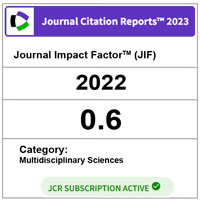Chemical composition in sugarcane bagasse: Delignification with sodium hydroxide
DOI:
https://doi.org/10.11113/mjfas.v15n2.1118Keywords:
Sugarcane bagasse, sodium hydroxide extraction, chemical characterization, retention time, organic compoundAbstract
Sugarcane Bagasse is a cheap agro-based waste material. These biomass materials have a lot of potential to be converted into useful products such as carbon. Sugarcane Bagasse was extracted by Sodium Hydroxide. Several characterizations has been done to analyse the chemical properties of Sugarcane Bagasse after extraction by Sodium Hydroxide including FTIR, XRF, HPLC and SEM-EDS. SEM shows an increases in internal surface area of the lignocellulose particles, as well as weakening the structural while EDS shows 60.59 % content of carbon. HPLC results show some peak at different retention time. The organic compound can be observed by at retention time 9.611 minute with 66.428 % height and it was identified as schaftoside. FTIR shows that when peak at 1096 cm-1 to 1638 cm-1 there was presence of H-O-H (water adsorption). The element with the highest concentration that are found by using XRF in untreated sugarcane bagasse is water, H2O (98.5 %), followed by Sodium, Na (0.669 %), and Sulfur, S (0.638 %). The concentration of each element were decreasing (except H2O) after being treated with NaOH. Sugarcane bagasse which is treated with alkaline solution is more suitable to be applied in the industry compared to acidic solution. This is due to the high reactivity of acidic solution that may damage the entire structural compounds of sugarcane bagasseReferences
Ahmed, F. M., Rahman, S. R., & Gomes, D. J. (2012). Saccharification of sugarcane bagasse by enzymatic treatment for bioethanol production. Malaysian Journal of Microbiology, 8(2), 97–103.
Carvalho, D. M. de. (2015). Study on the structure and properties of xylan extracted from eucalyptus, sugarcane bagasse and sugarcane straw (Doctoral dissertation, KTH Royal Institution of Technology, Stockholm). Retrieved from http://kth.diva-portal.org/smash/record.jsf?pid=diva2%3A 862284&dswid=-9656
Colombo, R., Yariwake, J. H., Queiroz, E. F., Ndjoko, K., & Hostettmann, K. (2009). On-line identification of minor flavones from sugarcane juice by LC/UV/MS and post-column derivatization. Journal of the Brazilian Chemical Society, 20(9), 1574–1579.
Da Penha, M. P., da Rocha Leão, M. H. M., & Leite, S. G. F. (2012). Sugarcane bagasse as support for the production of coconut aroma by solid state fermentation (SSF). BioResources, 7(2), 2366–2375.
Haung, H., Yang, S.-T., & Ramey, D. E. (2003). A hollow-fiber membrane extraction process for recovery and separation of lactic acid from aqueous solution. Applied Biochemistry and Biotechnology, 98–100(1–9), 311–318.
Maryana, R., Ma’rifatun, D., Wheni, I. A., K.W., S., & Rizal, W. A. (2014). Alkaline pretreatment on sugarcane bagasse for bioethanol production. Energy Procedia, 47, 250–254.
Maung, Y. M., Win, T. T., & Oo, A. T. (2015). Preparation and characterization of bagasse ash. International Journal of Technical Research and Applications, 3(1), 84–87. Retrieved from www.ijtra.com/ download.php?paper=316
Mohan, P. R., Ramesh, B., & Redyy, O. V. S. (2012). Production and optimization of ethanol from pretreated sugarcane baggase using Sacchromyces bayanus in Simultaneous Saccharification and Fermentation. Microbiology Journal, 2(2), 52-63.
Nakhla, D. A., & Haggar, S. El. (2014). A proposal to environmentally balanced sugarcane industry in Egypt, 2(9), 321-328.
Pandey, A., Soccol, C. R., Nigam, P., & Soccol, V. T. (2000a). Biotechnological potential of agro-industrial residues. I: Sugarcane bagasse. Bioresource Technology, 74(1), 69–80.
Pandey, A., Soccol, C. R., Nigam, P., Soccol, V. T. (2000b). Biotechnological potential of agro-industrial residues. I: Sugarcane bagasse. Bioresource Technology, 74, 69–80.
R. Bodîrlău, C.A. Teacă (2007). Fourier transform infrared spectroscopy and thermal analysis of lignocellulose fillers treated with organic anhydrides. January 2007. Romanian Journal of Physics, 54(1), 93-104.
Qi, G., Peng, F., Xiong, L., Lin, X., Huang, C., Li, H., Chen, X. (2017). Extraction and characterization of wax from sugarcane bagasse and the enzymatic hydrolysis of dewaxed sugarcane bagasse. Preparative Biochemistry and Biotechnology, 47(3), 276–281.
Rezende, C., de Lima, M., Maziero, P., deAzevedo, E. E., Garcia, W., Polikarpov, I., Griffin, R. (2011). Chemical and morphological characterization of sugarcane bagasse submitted to a delignification process for enhanced enzymatic digestibility. Biotechnology for Biofuels,
(1), 54.
Sahiron, N., Rahmat, N., & Hamzah, F. (2017). Characterization of sodium silicate derived from sugarcane bagasse ash. Malaysian Journal of Analytical Science, 21(2), 512–517.
Showalter, A. M. (1993). Structure and function of plant cell wall proteins. The Plant Cell, 5(1), 9–23.
Vila, F. C., Colombo, R., De Lira, T. O., & Yariwake, J. H. (2008). HPLC microfractionation of flavones and antioxidant (radical scavenging) activity of Saccharum officinarum L. Journal of the Brazilian Chemical Society, 19(5), 903–908.







